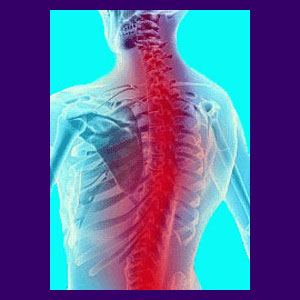
Neck and back pain is a typical combination of symptoms which may stem from a single spinal source, multiple spinal sources, a soft tissue condition or even a psychosomatic causation.
Spinal injury is certainly one of the most probable explanations for widespread pain in multiple areas of the spine. A serious spinal abnormality might also exist in the neck and affect all the anatomical functions below the affected vertebral level. Some pain conditions that move throughout the spine are blamed on muscle imbalances, “domino effect” or spinal instability. With all these possible causes and contributors to symptoms in the neck and back, patients may be hard-pressed to discover the true reason(s) for their pain. Remember, accurate and successful diagnosis of any single pain expression in the back may be challenging, but pinpointing the cause or causes of multiple locations of symptoms can be exponentially more difficult.
This dissertation delves into the most common combination of neck and back pain symptoms and how they may or may not be related in origin.
Neck and Back Pain Expressions
Many patients have a primary pain zone in either the cervical or lumbar spinal region. This is the area of their main symptomatic occurrence. However, there are times when the pain in the primary location gets much better, often to be replaced by pain in the secondary symptomatic region.
This type of morphing and migrating pain is rarely the result of a single anatomical cause. Either multiple spinal pathologies or a psychoemotional condition is far more likely to be the actual cause of pain in both locations. In the latter example of mindbody expressions, this is a classic example of back pain substitute symptoms.
Pain in the neck and upper back have a much greater chance of being directly related, since these regions work hand in hand to provide much of our physical functionality. These pain syndromes may be sourced from a single spinal pathology or a regional process affecting the vertebral column or the soft tissues.
Neck pain and sciatica can also be linked, usually due to the occurrence of severe spinal stenosis in the cervical region. However, being that many cases of lumbar pathologies can also source sciatic nerve symptoms, and are incredibly commonplace, multiple causations may exist in these patients as well.
Confused yet?
Back and Neck Treatment
Most doctors love to connect symptoms together in often illogical ways. Look at the example of fibromyalgia. In this pain syndrome, there are a variety of symptoms that do not seem to come from any particular singular cause. Yet somehow, they are linked together under a common nomenclature, in order to make diagnosis easy.
Beyond diagnosis comes treatment and a condition with multiple symptoms often requires multiple treatments, making these combination pain syndromes very profitable. Back and neck pain may or may not be 2 sides of the same coin. Assuming that they are related without definitive evidence is just as bad as assuming they are separate and distinct without verifiable reason.
So many patients are placed into treatment prematurely for a single causative issue without the benefit of proper evaluation of secondary pain locations. This is simply because diagnosis is difficult and time consuming work which is not very profitable. Meanwhile, treatment is simple and a great money maker. If you are a doctor, why spend time on evaluation and consideration of evidence when you could be counting your money? Sure, this may be an oversimplification in some cases, but is certainly a relevant comment on the modern healthcare system.
Neck and Back Pain in Combination
This is a combination back pain syndrome that is so much a part of my own symptomatic journey. Going back in time, my main back pain complaint was always in my lumbar spine (L4/L5 and L5/S1), but I also experienced times when the chronic lumbar pain would lessen and I would instead develop stiff and painful neck muscles. I do not recall ever having both pains simultaneously. My care providers always blamed this on some illogical muscular compensation theory.
My chiropractors believed that the pain moving to my neck proved that they were helping my lower back (silly). Other doctors said my entire back problem was a result of muscle imbalance (sillier). Many therapists told me my lower back pulled on my spine causing a domino effect and created pain radiating all the way into the neck (silliest). Now, I have some truly dire cervical issues, including the first 10 discs in my spine all being herniated (as well as 2 in my lumbar, still). My neck has become just as much of a concern as my low back, if not more so, since one cervical disc is really doing some nasty looking things to my spinal cord.
I have daily pain in both locations and at this point have no real explanation for the lower back issues. The middle back also hurts much of the time and I have constant radiating heat down my neck and into one or both shoulders. Standing is a torment, but sitting is far worse. I am basically never comfortable with these multiple locations of chronic misery. Neck and back pain has become my life. Luckily time and continued effort allowed me to find a true cure for my suffering and I am now pain free.
Back and neck symptoms is a very common pair of torturous conditions. When I talk to a patient with this variety of pain, I always feel twice affected, both out of sympathy for them and empathy for the suffering we share. If you are experiencing recurrent alternating neck and back pain that has resisted all attempts at treatment, consider the possibility that your diagnostic process may still need to evolve. Sometimes, it takes starting over with a new doctor to get the best results. I wish you good luck!





